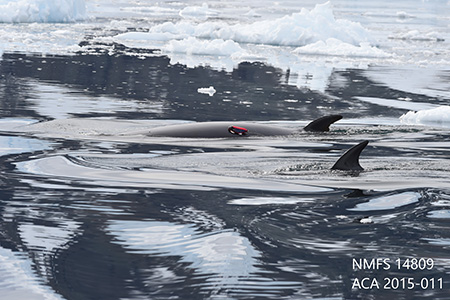Cameras attached to a rare species of Antarctic whale are giving scientists an unprecedented view of how the whales survive in their sea ice habitat, according to new research presented at the 2020 Ocean Sciences Meeting in San Diego.
In a recent study, scientists attached tags to 30 Antarctic minke whales, a small and little-known species of baleen whale, to better understand the animals’ sea ice environment. The tags, clinging to the animals’ backs with suction cups, recorded video and motion data for 24 to 48 hours.
Each time the whales surfaced, the researchers could calculate from the video how much sea ice was present, providing clues as to how the amount and type of sea ice influenced the whales’ behavior.
Previous research had relied on satellite images to study the whales’ habitat, but scientists needed to get closer to truly understand how these creatures were moving through their sea ice environment.
“It’s unique in that we’ve never been able to measure this kind of an environmental feature from the animal’s perspective,” said Ari Friedlaender, an ecologist at UC Santa Cruz who led the project. “These tags have the capacity to continuously show us the environment the animal is experiencing, which is absolutely novel for us.”
While the research is still ongoing, preliminary data from the whale cams are already revealing surprising results, according to the researchers. From the six tags analyzed so far, the researchers saw whales were spending 52 percent of their time in open water compared to just 15 percent in water with high concentrations of sea ice.
As Antarctic sea ice continues to shrink under climate change, understanding its importance for the whales will be crucial for protecting them, according to the researchers.
“A lot of [previous work] with these cameras has been focused on animal behavior, which was originally one of the intentions that we had for our cameras,” said Jacob Linsky, a research technician at UC Santa Cruz who helped develop the new technique. “But we happen to have stumbled upon a great way to monitor the environment with this mobile platform, which is something that hasn't been done in the marine environment before.”
As the tagged minke whales swam and dived under the ice, the scientists also learned new things about the cryptic species and its behavior. The piggybacking cameras allowed scientists a whale’s-eye view of a day in the life of an Antarctic minke—its feeding habits, social life, and where it spent the most time.
Linsky is presenting the team’s findings in a talk on Friday, February 21, at the Ocean Sciences Meeting in San Diego.
As the researchers evaluate more of the tags, they will be able to tell whether minke whales prefer to forage in areas with more or less sea ice. This will help scientists determine the species’ ecological role—and how to best protect it.
“What I'm most interested in is learning as much as we can about the behavior and the needs of these animals so that we can better understand the impact that climate change has on them,” Friedlaender said.



